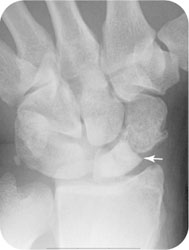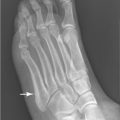George M. Bridgeforth, Thomas Hearty, and Charles Carroll IV
A 42-year-old man presents with left wrist pain after an injury that occurred 4 months ago.

CLINICAL POINTS
- A poor blood supply may be associated with a higher risk of AVN.
- Lack of blood to the scaphoid may lead to arthritis.
- Many patients with long-standing degenerative arthritis of the wrist may have had chronic instability from a preexisting wrist injury (i.e., unstable fracture or ligament tear) several years earlier.
Clinical Presentation
Avascular necrosis (AVN) is the death of bone tissue due to a lack of blood. There may be poor retrograde blood flow from the distal to the proximal scaphoid. This can result in tiny breaks in the bone and the bone’s eventual collapse.
The scaphoid is the most frequently fractured wrist bone (see Chapter 38, “Scaphoid Fractures”), and AVN is the most common complication of a scaphoid fracture, occurring in 15% to 30% of cases. Trauma leading to displaced scaphoid fractures is the most likely cause of AVN. Much less common is an idiopathic osteonecrosis of the scaphoid. The risk of AVN depends on the location of the fracture. The proximal one-third has the highest incidence of AVN. The middle one-third, the most frequent fracture site, is associated with a moderate risk of AVN, and fracture in the distal one-third rarely leads to AVN. The proximal segment is most susceptible to damage because of the retrograde vascular supply, making the proximal vascularity the most tenuous. Acute AVN is more likely to follow a displaced scaphoid fracture greater than 1 mm, usually at the middle (waist), or an acute fracture involving the proximal pole. In addition, a poor blood supply, as occurs in diseases such as diabetes, may increase the risk.
Long-standing cases of AVN of the scaphoid may result in a degenerative arthritis of the wrist; this complication is caused by longstanding carpal instability. Patients present with unilateral involvement and complaints of joint pain; stiffness, with decreased range of motion; pain with activities such as lifting or gripping; and hypertrophy. Other carpal fractures or dislocations may also cause long-term instability and a degenerative arthritis.
Other conditions may cause arthritis of the wrist. The presence of bilateral acute wrist pain or recurrent wrist pain is more likely secondary to a rheumatoid arthritis. Flare-ups consist of signs of recurrent acute inflammation, including pain, redness, swelling, tenderness, and warmth. Rheumatoid arthritis usually has a bilateral distribution, and other joints such as the knee, metacarpals, and proximal interphalangeal joints may be affected.
Gout may present as an oligoarthropathy affecting the wrist. Most patients have signs of acute inflammation characterized by marked acute swelling, redness, warmth, and tenderness. Moreover, a prior history of gouty attacks, which usually affect the great toe, knee, or ankle, may indicate this diagnosis. Psoriasis may also lead to an oligoarthritis that affects the wrist. Patients usually have clinical manifestations of psoriasis—salmon-colored plaques with silver reticuli over the knees, elbows, lower back, and gluteal regions. In addition, there may be pitting of the nails (very small groups of indentations) as well.
PATIENT ASSESSMENT 
- Pain, swelling, and tenderness over the scaphoid at the anatomic snuffbox
- Pain-limited range of motion
- Possible clicking with recurrent subluxation during motion
Stay updated, free articles. Join our Telegram channel

Full access? Get Clinical Tree








